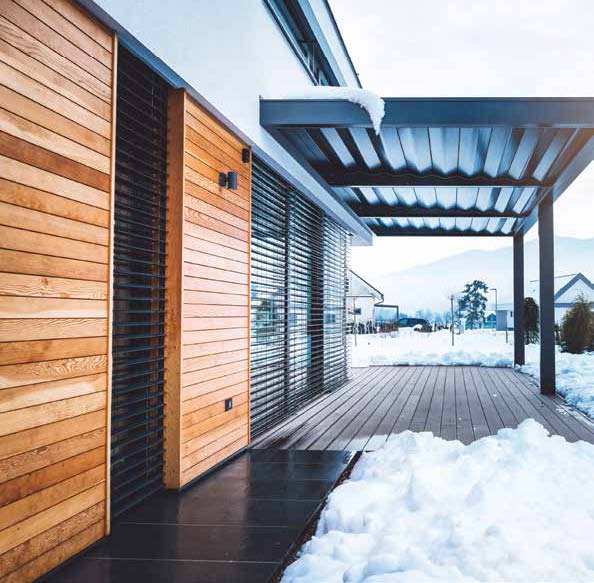Care and maintenance tips for a long-lasting deck or patio
 Deck season isn’t over after the summer months have passed. Now that it’s fall, and with the winter season not far behind, customers may be anxious to complete their deck or patio projects and enjoy whatever time they can in their outdoor spaces. But caring for a deck requires a specific game plan in order to ensure that it holds up to the end-of-the-year elements and stays beautiful beyond. Here are some tips for getting wood decks and concrete patios in shape and for helping customers understand proper care and maintenance.
Deck season isn’t over after the summer months have passed. Now that it’s fall, and with the winter season not far behind, customers may be anxious to complete their deck or patio projects and enjoy whatever time they can in their outdoor spaces. But caring for a deck requires a specific game plan in order to ensure that it holds up to the end-of-the-year elements and stays beautiful beyond. Here are some tips for getting wood decks and concrete patios in shape and for helping customers understand proper care and maintenance.
WOOD DECKS
Get rid of the old stain and sealer
There are a lot of reasons for restaining a deck. The stain may be worn out, discolored or peeling and flaking—or, the customer might just want to freshen up what was on their deck previously. When considering a freshening up, customers often want to know if a previously stained deck needs to be restained with the same kind of stain that was used before. In other words, is a water-based stain compatible with an oil-based formula?
Since some stains and sealers do not adhere well to others, it’s best to start by applying a deck-stain remover. This will get rid of the old stain and sealer that could prevent a new stain and sealer from adhering.
The next step is to use a product to neutralize the surface and bring back the natural color of the wood. Most deck cleaners vary on the pH scale, for instance, stain and sealer removers may have a high pH of 11 or 12, but in order for a coating to work properly, the pH surface typically needs to be neutral. To neutralize the surface, you need a cleaner of the opposite pH (reading 1 or 2). After neutralizing the surface, it’s important to test the absorbency of the wood by sprinkling water on the surface. If the water penetrates into the wood quickly, the wood is ready to finish. If the water beads up or does not soak in, the process needs to be done over again until the previous coating is completely removed so the new coating will adhere.
Use specially formulated cleaners, not bleach
Some think bleach is a good solution to clean a deck, however, it is not recommended, as it tends to be too harsh on the wood substrate as well as the vegetation typically planted around decks. All cleaners are not the same, and the contaminants on the deck may be unique to each region. For this reason, it is important to read all the package directions before choosing a cleaner and to test those products on a small, inconspicuous area prior to use.
Stay off the deck after staining
As a general guideline, if conditions are mild—the weather is dry and the temperatures are in the 70s—customers should be able to walk on their deck the next day or sooner, depending on the stain used. But it’s typically recommended to wait at least 24 to 48 hours before moving patio furniture back on the deck and returning it to active use.
CONCRETE PATIOS
Start with a clean surface before staining
Contractors often want to know the best way to stain an exterior concrete patio that is old and porous, and has never been previously coated. As always, it’s important to make sure the surface is completely clean and free of any grease or contaminants that could interfere with the adhesion of any coating.
To check if there is a sealer on the concrete, just sprinkle some water on it in multiple areas. If the water soaks in, that indicates there is not a sealer on the concrete. If the water beads up, that indicates that there is a sealer present and it will need to be removed. If it’s not removed, the new stain, sealer or coating will likely not adhere.
There are multiple ways to clean the surface; the type of cleaner required is dependent on what is on the concrete surface. If the surface presents grease, a good emulsifying agent will help remove it. It is also important to remove all loose mortar or foreign material, such as laitance, concrete dust, dirt or any loose cement and hardeners. Fill large holes, air pockets and other voids with concrete patch. Once it’s clean, dry and sound, you can stain away.
THE IMPORTANCE OF PROPER DECK AND PATIO CARE
When it comes to outfitting the outdoor space, the deck and patio are major focal points of a customer’s property. It’s important to consider the substrate, application tips, and aftercare needed to ensure a lasting space that customers can enjoy for years to come.
While some customers comprehend the value and importance of care, most don’t fully understand what proper care actually takes in terms of maintenance methods and products used. That’s where their contractor can be of great service.
Remind customers that in the battle of nature vs. under-protected concrete and wood, nature invariably wins. And that maximizing their investment in a deck or patio—and for that matter, their home—depends on a care program suited to their substrate. Some contractors offer a yearly maintenance plan as part of their services, which helps illustrate their commitment to proper maintenance, and also keeps them in front of their customers for other potential projects.
______________________________________________________________________________________________________________________
 Rick Watson has been with Sherwin-Williams for more than 30 years. He began his career in 1988 in the Management Training Program. Shortly thereafter, he became a professional coatings sales representative in Fort Wayne, IN. Since then, he has progressed through a number of roles of greater responsibility including store manager, product information team leader, product information manager and, most recently, director of product information and technical services.
Rick Watson has been with Sherwin-Williams for more than 30 years. He began his career in 1988 in the Management Training Program. Shortly thereafter, he became a professional coatings sales representative in Fort Wayne, IN. Since then, he has progressed through a number of roles of greater responsibility including store manager, product information team leader, product information manager and, most recently, director of product information and technical services.




